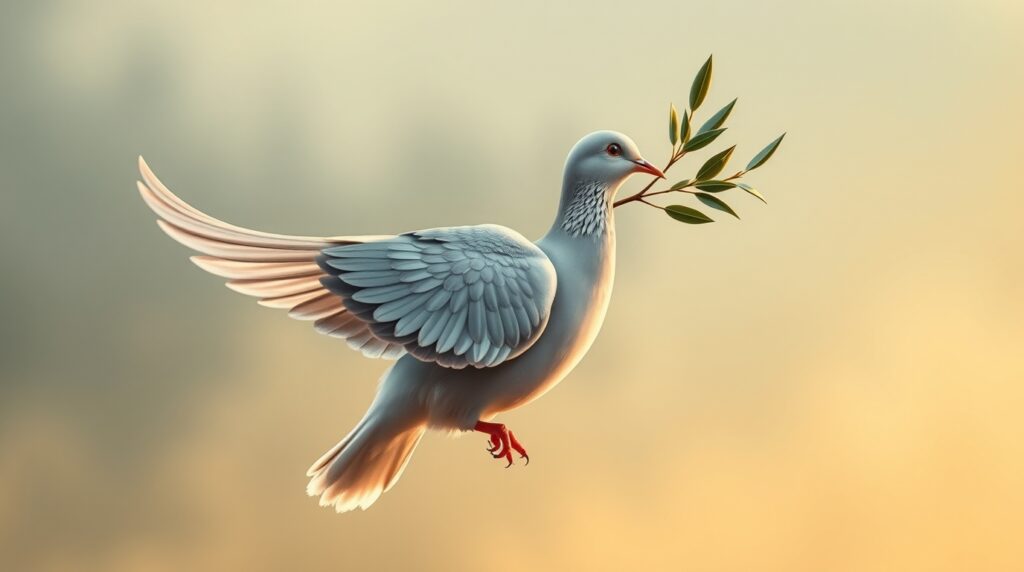The Dove and Beyond: Animals That Symbolize Peace Across Cultures
When we think of peace, a familiar image often comes to mind: a white dove in flight, perhaps carrying an olive branch. While the dove is the most universally recognized peace symbol in the animal kingdom, it is far from the only one. From ancient spiritual traditions to modern-day diplomacy, animals have long served as emblems for human values, including harmony, balance, and nonviolence. But why are certain animals—some gentle, some surprisingly fierce – chosen to represent peace? Let’s explore the fascinating interplay between animal behavior, cultural symbolism, and the universal human pursuit of peace.
Why the Dove Represents Peace
The dove as a peace symbol has both biological and cultural roots. Biologically, doves (particularly species like the Columba livia, or rock dove) are known for their monogamous pair bonding and nurturing behavior. They coo softly, show gentleness in interactions, and lack the aggression common in many other bird species. But it’s the cultural significance that gave them their worldwide reputation.
In Judeo-Christian tradition, a dove carrying an olive branch appeared after the biblical flood, signaling hope and renewal (Encyclopedia Britannica). Ancient Greeks also viewed the dove as sacred to Aphrodite, the goddess of love. This mental connection between love, calm, and the dove carried forward into modern times.
The image was most famously cemented in the public consciousness when Pablo Picasso chose the dove as the emblem for the 1949 Paris Peace Congress, a moment when the world was desperate for reconciliation after World War II.
Other Animals That Symbolize Peace Around the World
Although the dove often takes center stage, other animals have carried peaceful connotations across different civilizations and philosophies. Here’s a closer look:
| Animal | Cultural Context | Why It Symbolizes Peace |
|---|---|---|
| Dove | Christianity, Western diplomacy | Gentle nature, symbolic rebirth after chaos |
| Elephant | Buddhism, Hindu traditions | Represents wisdom, emotional intelligence, and silent strength |
| Crane | Japan, Chinese folklore | Graceful in flight, often symbolizes longevity and harmonious living |
| Lamb | Christianity, ancient Middle Eastern cultures | Innocence and non-aggression; often symbol of sacrificial peace |
| Deer | Native American, Celtic, Buddhist cultures | Gentle, prey-animal behavior; a creature that avoids conflict |
Biological Behaviors That Align with Peaceful Symbolism
It’s not just symbolic reasoning; many of these animals actually exhibit behaviors that humans interpret as peaceful. For instance, elephants, despite their size and power, are among the most emotionally intelligent mammals. They resolve conflicts within herds, mourn the dead, and even comfort each other with trunk touches and vocalizations, as detailed in studies by organizations like the World Wildlife Fund.
Similarly, cranes engage in synchronized dances that researchers believe promote pair bonding and cohesion, behaviors often translated into human ideas of unity and cooperation. Lambs and deer, while physically vulnerable, represent peace through their gentle, submissive demeanor and constant vigilance to avoid danger without using aggression.
Peaceful Animal Behavior: Nature’s Conflict Resolution
In ethology, the scientific study of animal behavior, conflict resolution in the wild is a fascinating area. While many assume that animals survive through aggression and dominance, the reality is that peacekeeping is often the more sustainable strategy. For instance, primates like bonobos are known to use affiliation gestures, grooming, and sexual behavior to reduce social tension.
The animals that humans associate with peace often display these types of nonviolent strategies for community living. Their behaviors create equilibrium in their social groups, a trait that humans have mirrored and idealized for thousands of years.
A Symbol That Speaks Globally
What makes animal peace symbols powerful is their universal readability. A white dove doesn’t need translation. A crane folding ceremony, like the senbazuru in Japan, speaks of hope and healing without words. These symbols transcend language and culture, weaving into ceremonies, protest movements, literature, and art. They remind us that peace is not just a political goal but a deeply emotional, communal, and even instinctual state of being.
So, while the dove might lead the flock in symbolic terms, it shares its message with quiet companions from all corners of the animal world, each offering a unique angle on what it means to live in harmony.
People Also Ask: Related Questions About Animals and Peace
Is the dove the only animal that symbolizes peace?
No, many animals symbolize peace in different parts of the world. Cranes, elephants, lambs, and deer also carry meanings of harmony and nonviolence in various cultures.
Why is the olive branch associated with doves and peace?
The combination comes from the biblical story of Noah’s Ark. When the dove returned with an olive branch, it signaled the end of the flood and the beginning of peace between God and humanity.
What does a white elephant symbolize in Buddhism?
In many Buddhist traditions, the white elephant is a sacred symbol of peace, purity, and mental strength. It signifies the arrival of enlightened beings and wisdom.
Are there any modern uses of animal peace symbols?
Yes. Doves are frequently used in political protests, memorial ceremonies, and peacebuilding artwork. Origami cranes are also a global peace symbol, especially following World War II.
Do animals themselves understand peace?
While peace is a human concept, many animals exhibit conflict-reducing behavior. From grooming rituals in apes to allomothering in elephants, these actions foster group harmony.


